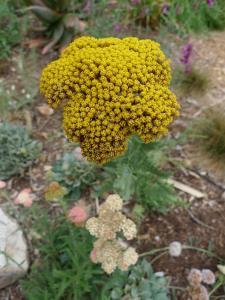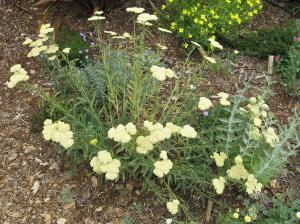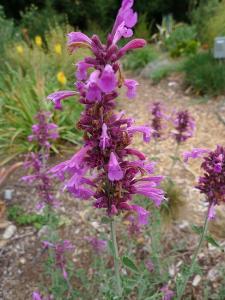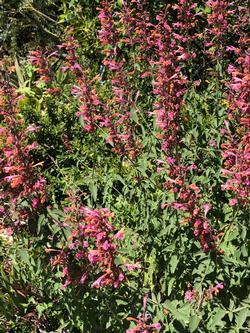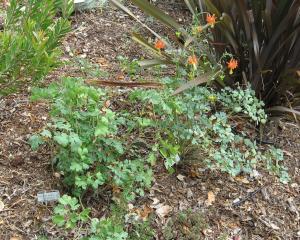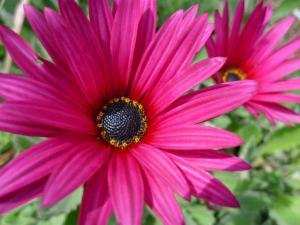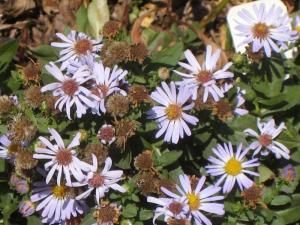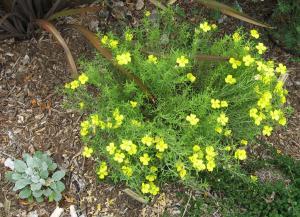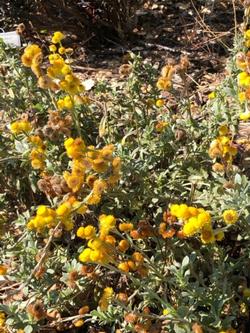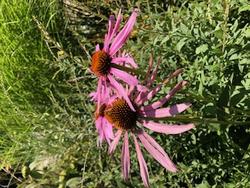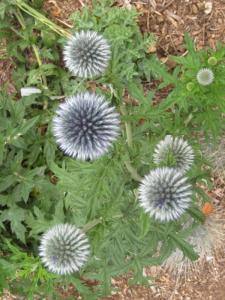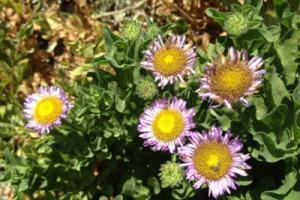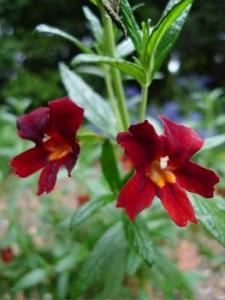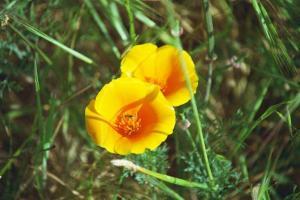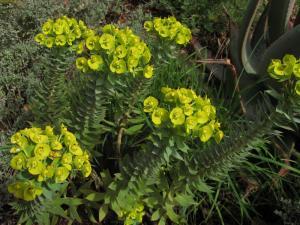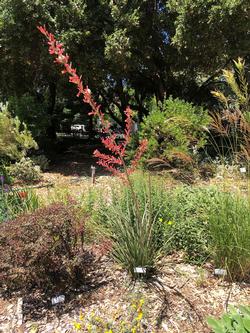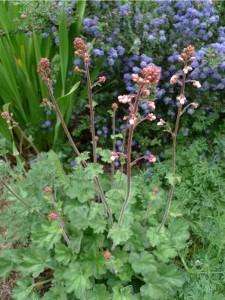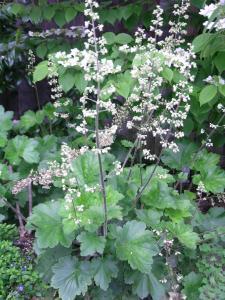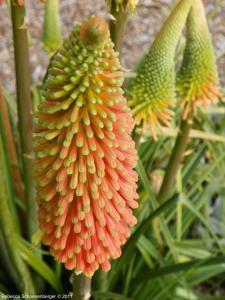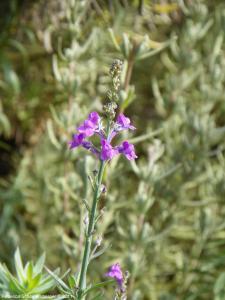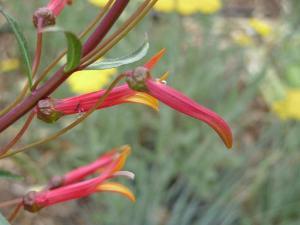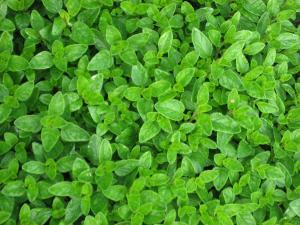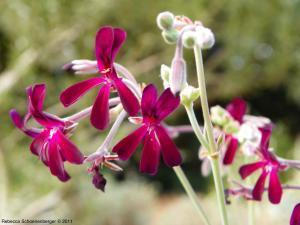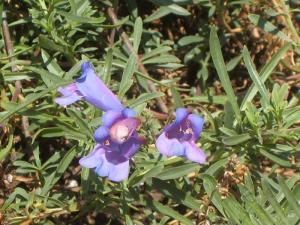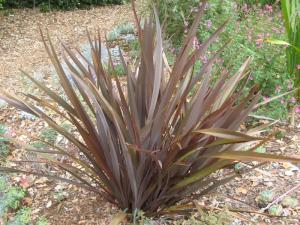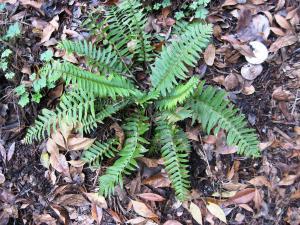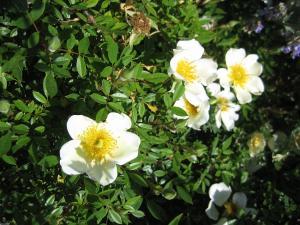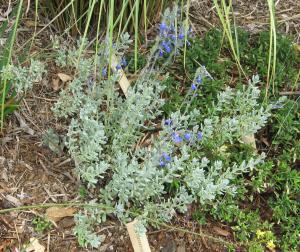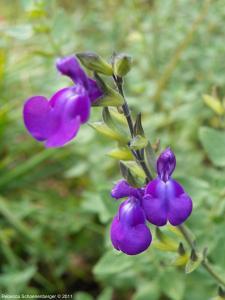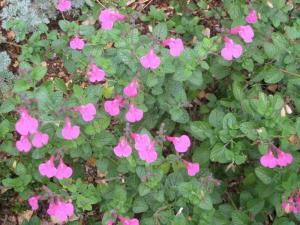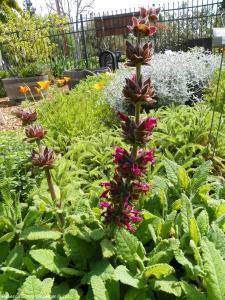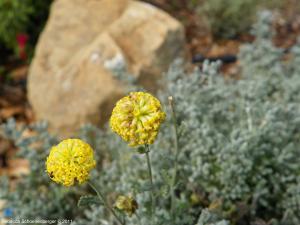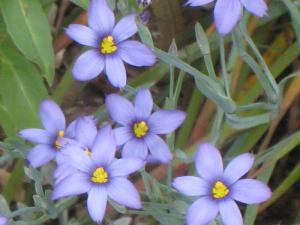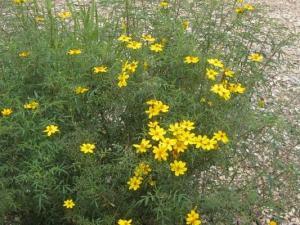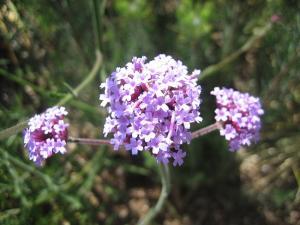Water Wise Plants
Here's a full list of all our water wise plants. You can also view an image gallery, or view the plants by categories.
Achillea ‘Moonshine’
Pronunciation
ah-KILL-lee-ah
Common Name
Yarrow ‘Moonshine’
Plant Type
Perennial
Mature Size
2 ft.
Water Requirements
Low: water every three weeks until the root ball is wet
Sun/Shade Requirements
Full sun
Wildlife
Flower Color
Bright yellow
Where to See
Maintenance- Design- Planting Tips
Achillea ‘Moonshine’ is a reliable mid-summer bloomer whose deep yellow flowers will stand out in a garden. Requiring very little maintenance, these plants are a magnet for butterflies and beneficial insects. The flowers have lots of nectar and the flat shape of the flower serves as a perfect landing pad for butterflies. Deadhead spent flowers to keep the plants looking fresh. Vigorous clumps can be divided in the winter. |
Achillea ‘Taygetea’
Pronunciation
ah-KILL-lee-ah tay-GET-ee-uh
Common Name
Yarrow ‘Taygetea’
Plant Type
Perennial
Mature Size
12 in. to 18 in. wide and tall
Water Requirements
Low: water every three weeks until the root ball is wet
Sun/Shade Requirements
Full sun
Wildlife
Flower Color
Creamy yellow
Where to See
Maintenance- Design- Planting Tips
‘Taygetea’ Greek yarrow is a cheerful, reliable summer bloomer. The flowers start out bright yellow in midsummer and fade to a more mellow shade over time. The grey-green foliage blends in well with many plants found in low water gardens. This cultivar of yarrow seems to be more drought tolerant than the popular Achillea millifolium.
Greek yarrow doesn't need a great deal of maintenance. To encourage reblooming, deadhead it regularly. This plant will spread, so don't plant it too tightly. |
Agastache
Pronunciation
ag-ah-STAK-ee
Common Name
Agastache
Plant Type
Perennial
Mature Size
3 ft. wide and 2 ft. tall
Water Requirements
Low: water every three weeks until the root ball is wet
Sun/Shade Requirements
Full sun
Wildlife
Flower Color
Pink
Where to See
Maintenance- Design- Planting Tips
Agastache are originally from the Southwest and Mexico, a climate that is somewhat different from Santa Clara County’s Mediterranean summer-dry climate. These plants require well-draining soil, but local soils tend to be slow-draining clay soils.
PADG notes: This unnamed cultivar of Agastache has been a mixed success in our gardens. |
Agastache ‘Acapulco Salmon and Pink’
Pronunciation
ah-ga-STAHK-ee
Common Name
Hummingbird mint
Plant Type
Perennial
Mature Size
2'-2.5' high x 1.5' wide
Water Requirements
Moderate: water weekly until the root ball is wet
Sun/Shade Requirements
Full to half sun
Wildlife
Flower Color
Orange and Pink
Where to See
Maintenance- Design- Planting Tips
Agastache ‘Acapulco Salmon and Pink’ is a beautiful accent plant for the late spring to early fall garden. It is more compact than most hummingbird mints and is densely covered by orange and pink flower spikes. The plant’s gray-green foliage is also a nice contrast to the brighter greens of most garden plants. Like many perennials, these plants die back during the winter. Hummingbird mints are only moderately drought tolerant. This plant does not flower well unless it is in full sun for half a day or more.
PADG notes: This specimen is planted where it gets morning sun and afternoon shade so it needs less water than recommended. During hot, summer periods, the plant is hosed weekly in addition to a once every three-week drip irrigation cycle. |
Aquilegia eximia
Pronunciation
ak-will-EE-jah Eks-IM-mee-uh
Common Name
Serpentine Columbine
Plant Type
Perennial
Mature Size
5 ft. high and 1.5 ft. wide
Water Requirements
Low: water every three weeks until the root ball is wet
Sun/Shade Requirements
Half sun
Wildlife
Flower Color
Yellow and orange
Where to See
Maintenance- Design- Planting Tips
Columbines are great plants for woodland areas. Their blooms are delicate and lovely. In the summer, the foliage tends to die back. Aquilegia eximia, a California native, is a UC Davis Arboretum All-Star plant.
PADG notes: Our Aquilegia eximia planted in partial sun hasn't done as well as we would like. We are trying it in a shady spot. The plant may need more water than our water wise garden is given. |
Arctotis ‘Purple Torch’
Pronunciation
ark-TOE-tiss
Common Name
African Daisy
Plant Type
Perennial
Mature Size
1 ft. to 1 1/2 ft. tall and wide
Water Requirements
Low: water every three weeks until the root ball is wet
Sun/Shade Requirements
Full sun
Wildlife
Flower Color
Purple
Where to See
Maintenance- Design- Planting Tips
Arctotis ‘Purple Torch’ is a low growing ground cover with gray felty leaves that are attractive even when there are no flowers. It begins blooming in the winter and continues until the weather gets hot. Other varieties of African daisy will bloom through the summer.
To keep Arctotis looking its best, the flowers should be regularly deadheaded when past their prime, and the plant should be replaced every few years. Cuttings root easily in the cool months. PADG notes: The Palo Alto Demonstration garden has planted ‘Purple Torch’ throughout the beds to unify the garden. It combines well with Bulbine frutescens, which blooms at approximately the same time. |
Artemisia douglasiana
Pronunciation
art-ee-MIS-ee-uh dug-las-ee-AH-nuh
Common Name
Douglas' Sagewort
Plant Type
Perennial
Mature Size
4 ft (1.2 m) wide x 8 ft (2.4 m) tall
Water Requirements
Moderate: water weekly until the root ball is wet
Sun/Shade Requirements
Half sun to shade
Wildlife
Flower Color
Cream, White, Yellow
Where to See
Maintenance- Design- Planting Tips
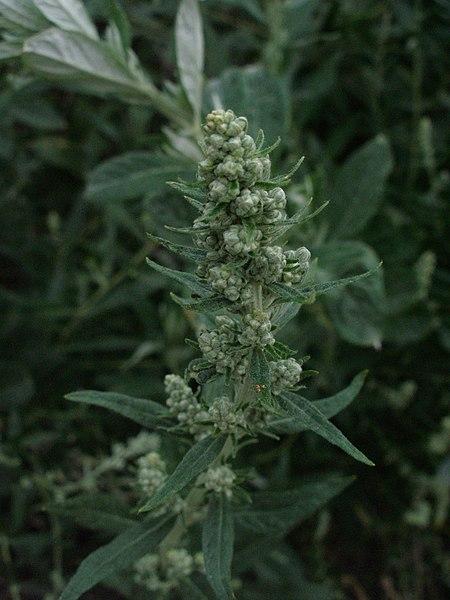
|
Aster chilensis
Pronunciation
ASS-ter chil-EN-sis
Common Name
California Aster
Plant Type
Perennial
Mature Size
2 ft. to 3 ft. wide and 18 in. to 3 ft. tall
Water Requirements
Very Low: water deeply several times a summer
Sun/Shade Requirements
Full to half sun
Wildlife
Flower Color
Purple, pale blue or white
Where to See
Maintenance- Design- Planting Tips
This California native is a low growing, late summer bloomer that shines when much of the garden is quiet. It works well in the front of a low water perennial bed or native plant border.
California aster looks best if regularly deadheaded. After it is done blooming in the fall, shear it back to the ground to keep a tidy look in the garden. The plant will cheerfully return when winter is over. PADG notes: California aster spread very rapidly even without supplemental water. It might work better in a situation where a rapidly spreading plant is needed for erosion control rather than in a small, mixed perennial bed. |
Calochortus luteus
Pronunciation
ka-lo-KOR-tus LU-teus
Common Name
Yellow Mariposa Lily
Plant Type
Perennial
Mature Size
.5 ft (0.2 m) wide x 1.6 ft (0.49 m) tall
Water Requirements
Very Low: water deeply several times a summer
Sun/Shade Requirements
Full to half sun
Wildlife
Flower Color
Yellow
Where to See
Maintenance- Design- Planting Tips
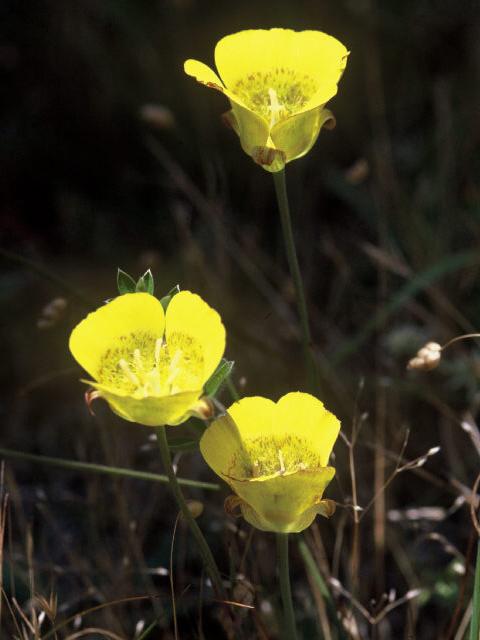
|
Calylophus hartwegii
Pronunciation
kal-ee-LOW-fus heart-WEHG-ee-eye
Common Name
Sundrops
Plant Type
Perennial
Mature Size
1.5 ft. high and 2 ft. wide
Water Requirements
Low: water every three weeks until the root ball is wet
Sun/Shade Requirements
Full to half sun
Wildlife
Flower Color
Where to See
Maintenance- Design- Planting Tips
Calylophus hartwegii is a showy, low growing perennial. The flowers, which appear in mid-summer, are bright yellow. The delicate, lacy foliage is also an attractive addition to the garden. It is native to the southwestern US and northern Mexico.
Sunset’s Western Garden Book suggests shearing before spring growth. The stems on these plants can become woody. |
Chrysocephalum apiculatum
Pronunciation
kry-soh-SEE-uh-lum uh-pik-yoo-LAY-tum
Common Name
Silver and Gold Everlasting
Plant Type
Perennial
Mature Size
1' high x 2'-3' wide
Water Requirements
Low: water every three weeks until the root ball is wet
Sun/Shade Requirements
Full sun
Wildlife
Flower Color
Where to See
Maintenance- Design- Planting Tips
Chrysocephalum apiculatum is a low growing perennial strawflower with standout silver foliage and yellow flowers. Like all strawflowers, the fresh spring blooms retain their color as they dry and last on the plant for long periods. When established this is a very drought tolerant plant. It works well near the front of a border but give space for its spread. It should not be planted next to the border’s edge. Trim the flowers when they become unsightly and lightly shape the plant for the next spring bloom. Do not prune heavily.
|
Clematis ligusticifolia
Pronunciation
KLEM-ah-tiss lin-GOOS-tik-uh-fo-lee-a
Common Name
Virgin's Bower
Plant Type
Perennial
Mature Size
2 - 6 in (5 - 15cm) wide x 1 - 30 ft (0.3 - 9.1 m) tall
Water Requirements
Low: water every three weeks until the root ball is wet
Sun/Shade Requirements
Full to half sun
Wildlife
Flower Color
White, Cream
Where to See
Maintenance- Design- Planting Tips
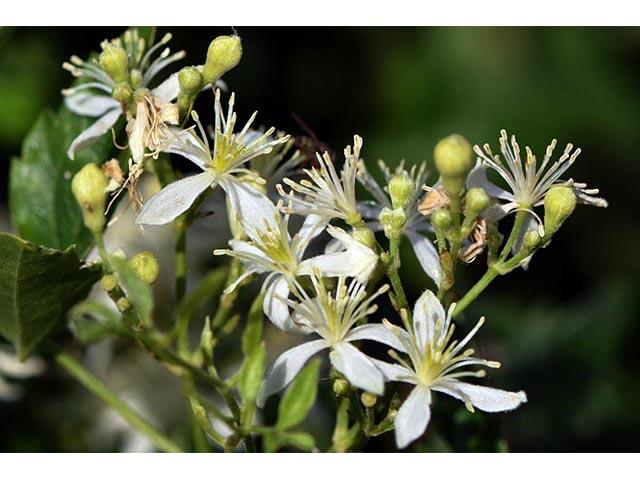
|
Echinacea purpurea
Pronunciation
ek-ih-AY-shee-a pur-PUR-ee-ah
Common Name
Purple cone flower
Plant Type
Perennial
Mature Size
3'-4' high x 2' wide
Water Requirements
Low: water every three weeks until the root ball is wet
Sun/Shade Requirements
Full sun
Wildlife
Flower Color
Purple
Where to See
Maintenance- Design- Planting Tips
Echinacea purpurea is a green-leaved perennial that produces large purple, daisy-like blooms in the summer. It can grow to four feet in height and works well in the background of garden borders. It needs minimal drip irrigation, dies down after bloom, and resprouts in the spring with little extra maintenance required. |
Echinops ritro ‘Taplow Blue’
Pronunciation
EK-in-ops RIH-tro
Common Name
Globe Thistle
Plant Type
Perennial
Mature Size
2 - 4 ft. tall and 2 ft. wide
Water Requirements
Low: water every three weeks until the root ball is wet
Sun/Shade Requirements
Full sun
Wildlife
Flower Color
Bright blue
Where to See
Maintenance- Design- Planting Tips
Echinops has beautiful blue flowers that bloom spring through fall. The coarse leaves may not appeal to everyone, but they add a different texture to the garden. Echinops make a great cut flower. The spiky texture adds interest to flower arrangements.
Even with minimal water and no fertilizer, these plants need staking. Supports put in place in the early spring are quickly covered with foliage and hidden from view. To encourage new blooms and keep the plant looking fresh, remove the entire flowering stalk. |
Erigeron glaucus ‘Wayne Roderick’
Pronunciation
er-IJ-er-on GLAW-kus
Common Name
Seaside Daisy ‘Wayne Roderick’
Plant Type
Perennial
Mature Size
1 ft. high and spreading up to 2 ft. wide
Water Requirements
Moderate: water weekly until the root ball is wet
Sun/Shade Requirements
Full to half sun
Wildlife
Flower Color
Pink to Lavender to Violet
Where to See
Maintenance- Design- Planting Tips
Erigeron glaucus ‘Wayne Roderick’ has a long bloom period if deadheaded regularly, with blooming starting in the spring and continuing into the fall. To keep this plant looking its best, prune back leggy growth to 1 or 2 inches in the late fall. The cultivar ‘Wayne Roderick’ is supposed to be longer lived, have larger blooms, and be more durable and heat tolerant than the species.
PADG notes: Our experience with Erigeron 'Wayne Roderick' has been very good, although we have noticed that the foliage burns in the summer unless given more frequent water. |
Erythranthe guttata
Pronunciation
er-EE-thranthe goo-TA-ta
Common Name
Monkey Flower
Plant Type
Perennial
Mature Size
2 1/2 ft. tall and wide
Water Requirements
Low: water every three weeks until the root ball is wet
Sun/Shade Requirements
Full to half sun, shade
Wildlife
Flower Color
White, cream, yellow, orange, copper, salmon, red, maroon
Where to See
Maintenance- Design- Planting Tips
Mimulus is a cheerful California native that adds bright color to the garden. This shrubby perennial has been hybridized heavily to produce a rainbow of colors. In the wild, different species of Mimulus can be found from southern Oregon to southern California.
Happy in sun or part shade, these plants prefer good drainage. With supplemental water, you can expect some repeat bloom all summer. Mimulus is a favorite in native plant gardens because of its color range. When new foliage appears at its base in late winter, the plant is ready to be pruned back to the new green growth. This hard pruning will rejuvenate the plant. If there is no growth at the base, then gently pinch the tips to encourage new growth. The scientific name of this plant was recently changed from Mimulus guttatus to Erythranthe guttata. PADG notes: Some Master Gardeners have found this plant to be short-lived; other Master Gardeners have Mimulus plants in their personal gardens that are over five years old and doing just fine. These plants are easy to propagate from cuttings and seeds. |
Eschscholzia californica
Pronunciation
esh-SHOLZ-ee-ah cal-ih-FOR-nih-kah
Common Name
California Poppy
Plant Type
Perennial
Mature Size
6 in. wide and 6 in. to 12 in. tall
Water Requirements
Low: water every three weeks until the root ball is wet
Sun/Shade Requirements
Full sun
Wildlife
Flower Color
Bright orange, golden, pale yellow, red, cream, rose
Where to See
Maintenance- Design- Planting Tips
California poppies look great in wild areas and are lovely massed. They make excellent temporary fillers in new beds and landscapes. California poppies can get by with almost no summer water, but they tend to look shabby and weedy under these conditions. To encourage continuous bloom, provide moderate amounts of water and trim the plants back to almost ground level when the foliage turns grey, and the plants lose their flowers. Although California poppies are perennials in the Santa Clara Valley, they can be treated as annuals. California poppies can be problematic because they are aggressive reseeders. They should be heavily thinned even in desired areas and removed entirely when undesired. They can reach one and a half feet wide in size and can smother other plants. Most retail nurseries and many hardware stores sell seeds for California poppies. Some mail order companies are good sources for some of the less common varieties of these California natives. Plant seeds in the fall for a spring show. Be sure to cover seeds with mulch to hide them from the birds and water regularly until they sprout if the winter rains have not arrived. |
Euphorbia rigida
Pronunciation
yew-FOR-bee-ah RIH-jih-dah
Common Name
Euphorbia
Plant Type
Perennial
Mature Size
3 ft. to 4 ft. high and wide
Water Requirements
Low: water every three weeks until the root ball is wet
Sun/Shade Requirements
Full to half sun
Wildlife
Flower Color
Where to See
Maintenance- Design- Planting Tips
Hundreds of varieties of Euphorbias are available ranging from groundcovers to shrubs. These Mediterranean perennials are hardy plants. Chartreuse or lime green flowers appear in late winter and hold well through spring. Euphorbias are very showy in the winter garden and continue looking good during the hot summer.
Euphorbias can be aggressive reseeders so cut off the flower stalks at the base sometime in May before they set seed. Be careful of the sap as it may irritate the skin. |
Grindelia hirsutula
Pronunciation
grin-DELL-ee-a hir-SU-too-la
Common Name
Great Valley Gumweed
Plant Type
Perennial
Mature Size
3 ft. wide x 2 - 6.6 ft (0.6 - 2 m) tall
Water Requirements
Very Low: water deeply several times a summer
Sun/Shade Requirements
Full sun
Wildlife
Flower Color
Yellow
Where to See
Maintenance- Design- Planting Tips
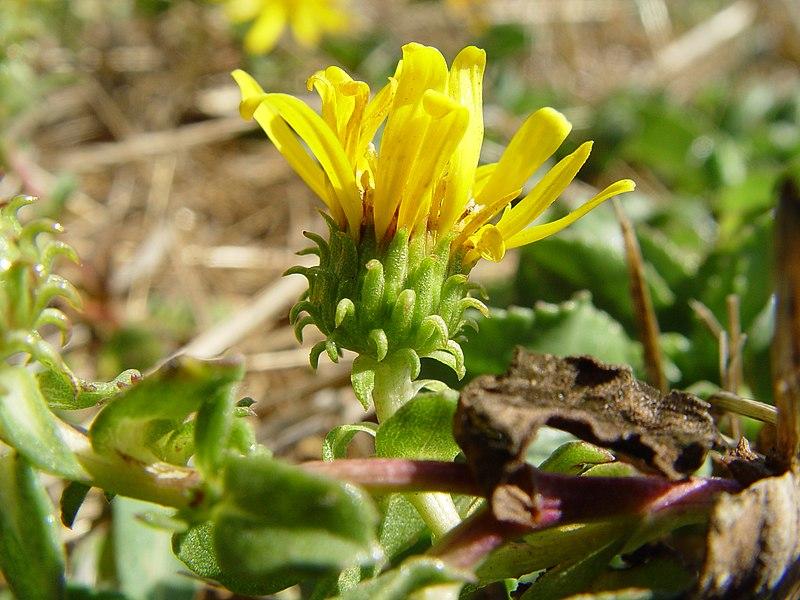
|
Hesperaloe parviflora
Pronunciation
hes-per-AL-oh par-VEE-flor-uh
Common Name
Coral yucca
Plant Type
Perennial
Mature Size
3'-4' high x 4'-5' wide
Water Requirements
Low: water every three weeks until the root ball is wet
Sun/Shade Requirements
Full to half sun
Wildlife
Flower Color
Red
Where to See
Maintenance- Design- Planting Tips
Hesperaloe parviflora is a standout plant for any garden and is on the UC Davis Arboretum All-Star list. The three- to four-foot-high rosettes of stiff yucca-like, blue-green leaves provide structural interest all year long. From spring into summer, five-foot-long flower stalks sport many striking red flowers followed by interesting seed pods. This plant is drought tolerant, low maintenance, and very reliable, with few pest and disease problems.
|
Heuchera ‘Rosada’
Pronunciation
HEW-ker-ah
Common Name
Coral Bells ‘Rosada’
Plant Type
Perennial
Mature Size
3 ft. to 4 ft. wide with 1 ft. flower stalks
Water Requirements
Moderate: water weekly until the root ball is wet
Sun/Shade Requirements
Half sun to shade
Wildlife
Flower Color
Pink
Where to See
Maintenance- Design- Planting Tips
There are many kinds of Heuchera, but Heuchera ‘Rosada’ is a favorite. Introduced to the nursery trade by the UC Davis Arboretum, it is a cross between two different western U.S. native species.
Heuchera ‘Rosada’ prefers light shade and occasional to moderate water. With beautiful rosettes of low growing foliage and stalks of pink blooms, it is a favorite of woodland gardens. Removing the flower stalks when the plant finishes blooming is all the maintenance needed. Although these plants will grow in full sun, they will need more water to look their best. Plants grown in the shade can tolerate less water. UC Davis Arboretum selected Heuchera ‘Rosada’ for its Arboretum All-Stars designation, which identifies plants that are easy to grow, reliable, do not need a lot of water, and have few pest or disease problems. |
Heuchera maxima
Pronunciation
HEW-ker-ah MAX-im-a
Common Name
Island Alumroot
Plant Type
Perennial
Mature Size
1-2 ft tall x 3-4 ft wide
Water Requirements
Low: water every three weeks until the root ball is wet
Sun/Shade Requirements
Full to half sun
Wildlife
Flower Color
Pinkish-white
Where to See
Maintenance- Design- Planting Tips
Heuchera maxima is a California native plant from the Channel Islands. This heuchera is one of the largest of this genus. It forms a low clump and looks great planted in mass, especially in early spring when delicate flowers appear on thin stalks above the large green leaves. The flowers are useful as a cut flower. It is on the UC Davis Arboretum All-Star list
PADG notes: In the Water Wise Garden, several Heuchera maxima are growing in a shady spot where the soil is quite rich. These plants have grown very large and are stunning in the spring when they bloom. |
Kniphofia
Pronunciation
ny-FOE-fee-ah
Common Name
Red Hot Poker
Plant Type
Perennial
Mature Size
Varies by cultivar
Water Requirements
Low: water every three weeks until the root ball is wet
Sun/Shade Requirements
Full to half sun
Wildlife
Flower Color
Red, orange, yellow, near white
Where to See
Maintenance- Design- Planting Tips
The glowing torch-like flowers spikes of Kniphofia are reliable midsummer bloomers and provide great vertical accents. Many sizes and colors of Kniphofias have been developed, including reds, oranges, yellows, and near whites. The flower colors can be dramatic and intense, so take care in selecting flower colors that blend well with your plants.
Deadhead the plants when the old flower spikes become unattractive. When the leaves start looking shabby in the winter, cut the foliage back about three inches above the ground. Kniphofia will come back beautifully in the spring. The plant divides easily but it doesn't seem to require dividing to stay vigorous. PADG notes: The Palo Alto Demonstration Garden has several Kniphofias including ‘Christmas Cheer', which is a UC Davis Arboretum All-Star. It has brilliant orange buds that open to a deep-gold tubular flower. ‘Christmas Cheer’ blooms in the fall and winter unlike many other Kniphofias. |
Linaria purpurea
Pronunciation
lin-AR-ee-uh pur-PUR-ee-uh
Common Name
Purple Toadflax
Plant Type
Perennial
Mature Size
2 - 3 ft. high and 1 ft. wide
Water Requirements
Low: water every three weeks until the root ball is wet
Sun/Shade Requirements
Full to half sun
Wildlife
Flower Color
Where to See
Maintenance- Design- Planting Tips
Linaria is an old friend that asks for little and gives much. This plant makes a great filler, especially in a young garden. The flowers are small, but the plant is large with many blooming branches. Sunset recommends planting these plants in mass for maximum impact.
The big drawback to Linaria is that it reseeds. The seedlings are easy to spot and pull out. If you deadhead the flowers and mulch your soil regularly you will cut down on the amount of reseeding. |
Lobelia laxiflora
Pronunciation
lo-BEE-lee-ah laks-ih-FLO-ruh
Common Name
Mexican Lobelia
Plant Type
Perennial
Mature Size
3 ft. to 6 ft. wide and 3 ft. tall
Water Requirements
Low: water every three weeks until the root ball is wet
Sun/Shade Requirements
Full to half sun
Wildlife
Flower Color
Red with yellow tips
Where to See
Maintenance- Design- Planting Tips
Many Lobelias need lots of water, but not this lovely red Mexican lobelia. Though very frost tender, Mexican lobelia comes back from the root stock in the spring. This lobelia can spread aggressively, so it is not recommended for someone looking for a low maintenance plant.
PADG Notes: After frost damage, scraggly branches are pruned back to about three feet for a neater appearance. When danger of frost is gone, the plant is pruned to the ground. Mexican lobelia has spread aggressively in the garden and needs regular root pruning to keep under control. Warning: Lobelia may cause serious illness or death if eaten. If ingested, immediately call the Poison Control Center or your doctor. In addition, the juice or sap of the plant can cause a skin rash or irritation. Wash the affected area of skin with soap and water as soon as possible after contact.
|
Maianthemum stellatum
Pronunciation
mie-ANTH-uh-moom stel-AH-toom
Common Name
False Solomon Seal
Plant Type
Perennial
Mature Size
1 - 2 ft. (0.3 - 0.6 m) wide x 2.5 ft.(0.8 m) tall
Water Requirements
Low: water every three weeks until the root ball is wet
Sun/Shade Requirements
Shade
Wildlife
Flower Color
White, Red
Where to See
Maintenance- Design- Planting Tips
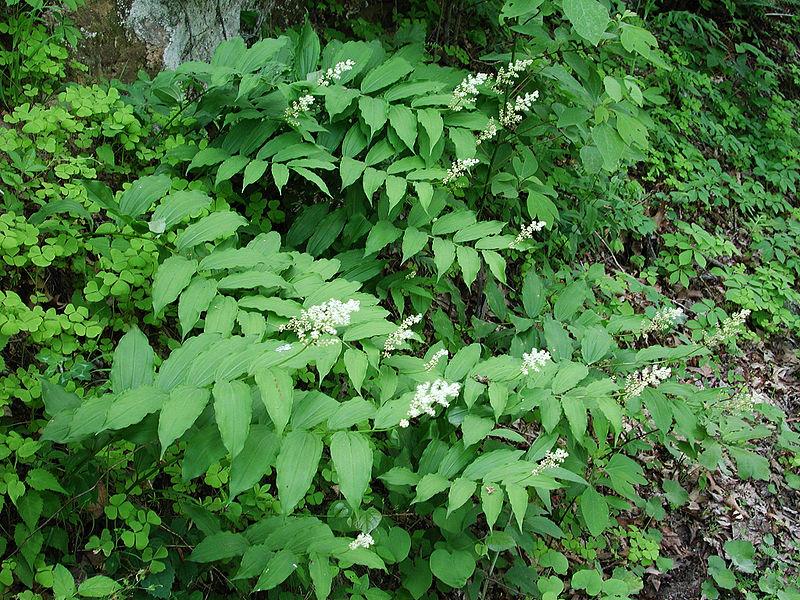
|
Origanum
Pronunciation
oh-Rig-an-um
Common Name
Oregano
Plant Type
Perennial
Mature Size
Varies depending on cultivar
Water Requirements
Low: water every three weeks until the root ball is wet
Sun/Shade Requirements
Full sun
Wildlife
Flower Color
No flowers
Where to See
Maintenance- Design- Planting Tips
Herbs like oregano are very attractive, can be mixed with ornamental plantings and thrive under tough conditions. Some oreganos are grown for their aromatic qualities, others for their interesting foliage and others for their attractive flowers. 'Hopley's', a variety with purplish pink flowers that is attractive in pots. 'Aureum', the variety shown in this picture, looks better with morning sun. The hot afternoon sun can bleach its leaves.
Herbs are also great for attracting beneficial insects to gardens. And the less they are watered, the more intense the flavor. Many oreganos benefit from being sheared to the ground in the fall. Harvest oregano any time for cooking, but the most intense flavor is just before the plants bloom. |
Pelargonium sidoides
Pronunciation
pe-lar-GO-nee-um sih-DOY-deez
Common Name
African Geranium
Plant Type
Perennial
Mature Size
1 ft. wide and tall forming a dense mound
Water Requirements
Low: water every three weeks until the root ball is wet
Sun/Shade Requirements
Full to half sun
Wildlife
Flower Color
Dark purple
Where to See
Maintenance- Design- Planting Tips
Pelargonium sidoides has elegant dark purple flowers and dense mounds of silver-gray, heart-shaped leaves. Masses of the dark purple flowers bloom all the way through mid-December with or without deadheading. Even without flowers, African geranium still looks great in the garden because of its attractive foliage.
This is a geranium that thrives in low water situations and in full sun. It can also do well in part shade with generous water. This cultivar seems to be more cold hardy than other Pelargonium. The only regular maintenance it needs is occasional deadheading. |
Penstemon 'Margarita BOP'
Pronunciation
PEN-steh-mon
Common Name
Foothill Penstemon
Plant Type
Perennial
Mature Size
1 ft. to 2 ft. wide, 2 ft. to 3 ft. tall
Water Requirements
Very Low: water deeply several times a summer
Sun/Shade Requirements
Full to half sun
Wildlife
Flower Color
Where to See
Maintenance- Design- Planting Tips
Penstemon 'Margarita BOP' is a UC Davis “All-Star” because it does well in average garden conditions. Unlike many other California native plants, Foothill penstemon can tolerate some summer water. The bright blue flowers on these plants are stunning and last well into late summer, especially if deadheaded regularly.
|
Phormium tenax 'Amazing Red'
Pronunciation
FORM-ee-um TEN-ax
Common Name
New Zealand Flax 'Amazing Red'
Plant Type
Perennial
Mature Size
3 ft. wide and tall
Water Requirements
Low: water every three weeks until the root ball is wet
Sun/Shade Requirements
Full to half sun
Wildlife
Flower Color
Red (but grown more for foliage)
Where to See
Maintenance- Design- Planting Tips
'Amazing Red' is one of the smaller Phormium cultivars. The sharp texture and brownish-red color of the leaves makes this plant an excellent focal point in the perennial bed.
Some Phormiums revert to the brownish color of the species after several years. 'Amazing Red' has held its color in the demonstration garden for six years and for ten years in some Master Gardeners' personal gardens. To maintain, prune out dead leaves at their base, but don't try to reduce size of Phormiums by cutting back the leaves. Unlike grasses, Phormium leaves won't grow back, leaving stubby unattractive leaves. PADG notes: Though it is supposed to be small, in the demonstration garden this plant has grown to about 3 feet high and wide in six years, larger than expected. The plant has not bloomed. |
Polystichum munitum
Pronunciation
pol-ISS-tih-kum MEW-nih-tum
Common Name
Western Sword Fern
Plant Type
Perennial
Mature Size
3 - 5 ft. tall and 3 - 4 ft wide
Water Requirements
Low: water every three weeks until the root ball is wet
Sun/Shade Requirements
Shade
Wildlife
Flower Color
No flowers
Where to See
Maintenance- Design- Planting Tips
Western sword ferns are found in in forests throughout California and much of the west. These ferns help give shady landscapes a natural woodsy look. These plants are very tolerant of competition from tree roots. To keep them looking attractive, remove older fronds. Keep in mind that sword ferns provide forage for elk, deer, and black bears, should you wish for any of these animals in your garden.
|
Ranunculus californicus
Pronunciation
ruh-NUNK-ew-loos kal-i-FOR-ni-koos
Common Name
California Buttercup
Plant Type
Perennial
Mature Size
6 in (15cm) wide x 0.6 - 2.3 ft (0.18 - 0.7 m) tall
Water Requirements
Moderate: water weekly until the root ball is wet
Sun/Shade Requirements
Full to half sun
Wildlife
Flower Color
Yellow
Where to See
Maintenance- Design- Planting Tips
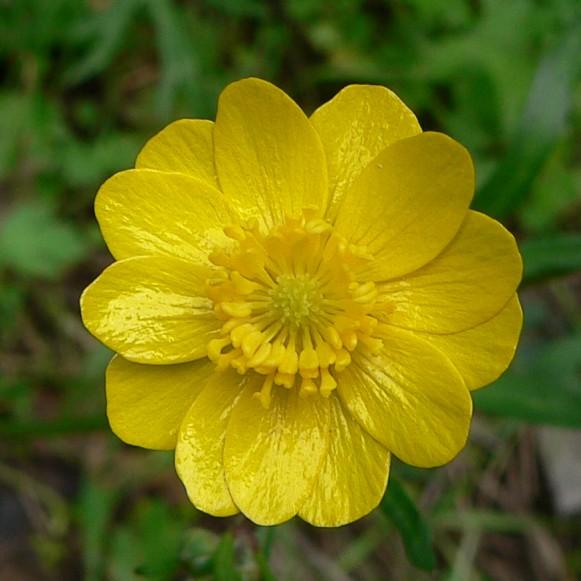
|
Rosa 'Happenstance'
Pronunciation
ROE-sah
Common Name
Rose 'Happenstance'
Plant Type
Perennial
Mature Size
3 ft. tall and wide with regular pruning
Water Requirements
Low: water every three weeks until the root ball is wet
Sun/Shade Requirements
Full sun
Wildlife
Flower Color
Light yellow to white
Where to See
Maintenance- Design- Planting Tips
Roses have a reputation for being lovely shrubs that require a lot of maintenance and water. 'Happenstance' rose is a beautiful, disease-free shrub rose that does fine on a low water diet.
The pale-yellow flowers of 'Happenstance' provide a calming contrast to more brightly colored flowers. The arching branches of 'Happenstance' rose form a neat mound. PADG Notes: This rose is a slow grower in the garden and doesn't need a lot of deadheading or pruning because it is not highly fertilized or watered. In February, some of the longer canes of 'Happenstance' are pruned back to about two feet to keep the rose a three-foot mounding shrub over the summer. Despite the low maintenance approach, this plant blooms continually in the spring, summer, and fall. It is highly recommended as a medium-sized rose for water-wise perennial gardens. |
Salvia chamaedryoides
Pronunciation
SAL-vee-uh kam-ay-dry-OY-deez
Common Name
Germander Sage
Plant Type
Perennial
Mature Size
2 ft. wide and 3 ft. to 4 ft. tall
Water Requirements
Low: water every three weeks until the root ball is wet
Sun/Shade Requirements
Full sun
Wildlife
Flower Color
Bright blue
Where to See
Maintenance- Design- Planting Tips
|
Salvia Hybrid 'Christine Yeo'
Pronunciation
SAL-vee-uh
Common Name
Sage 'Christine Yeo'
Plant Type
Perennial
Mature Size
12-18 in. high and 24 - 36 in. wide
Water Requirements
Low: water every three weeks until the root ball is wet
Sun/Shade Requirements
Full to half sun, shade
Wildlife
Flower Color
Where to See
Maintenance- Design- Planting Tips
Salvias microphyllas is a shrubby perennial that come in a wide variety of colors and will bloom many months with deadheading. It stays a manageable size in the garden and will not overwhelm neighboring plants.
The flower pictured here is Salvia hybrid 'Cristine Yeo'. It is a cross between Salvia microphylla and Salvia chamaedryoides. PADG Notes: Salvia microphyllas prefer full sun, but this plant is doing well with morning sun and afternoon shade in our garden. It seems a little floppy, which might be a shade issue or just its natural form. With a little work, the Salvia microphyllas can be kept in top form in your garden. At PADG, all flowers are sheared off in early summer and again during fall clean up. This keeps the plant more compact and encourages repeat blooming. In the spring, one third of is oldest stems are pruned out to keep the plant from getting woody. A nice bonus for pruning work -- the leaves of these Salvias smell wonderful. |
Salvia microphylla 'UCB Pink'
Pronunciation
SAL-vee-uh My-kro-FIL-uh
Common Name
Sage 'UCB Pink'
Plant Type
Perennial
Mature Size
3 ft. to 4 ft. wide and tall
Water Requirements
Low: water every three weeks until the root ball is wet
Sun/Shade Requirements
Full sun
Wildlife
Flower Color
Maintenance- Design- Planting Tips
This hot pink Salvia blooms in late fall when few other plants are blooming. In general Saliva microphylla plants do well in summer-dry perennial gardens and don't need a great deal of maintenance.
PADG Notes: 'UCB Pink' seems to bloom more consistently than many of the Salvia microphylla types. In the fall, the skinny branches of this plant are sheared off to form a neat ball. Avoid cutting into the thicker woody stems because it could affect regrowth. Regular pruning keeps this plant fuller and encourages more flowering the next season. If you want to learn more about Salvias, we suggest reading Betsy Clebsch's book called The New Book of Salvias. |
Salvia spathacea
Pronunciation
SAL-vee-a spa-THAY-see-a
Common Name
Hummingbird Sage
Plant Type
Perennial
Mature Size
1-2 ft high x spreading
Water Requirements
Very Low: water deeply several times a summer
Sun/Shade Requirements
Full to half sun, shade
Wildlife
Flower Color
Red
Where to See
Maintenance- Design- Planting Tips
Salvia spathacea is a California native plant with an unusually (for California natives) lush appearance. The leaves of this plant are large and can grow up to a foot in length.
The plant spreads by underground rhizomes and can eventually cover a large area. Hummingbird sage can make a colorful ground cover in dry, shady conditions. From spring until fall, flowering stems appear above the foliage. The flower clusters are spaced evenly along the stems creating a bold vertical accent. Light pruning after blooming will help keep this plant neat. PADG Notes: In the PADG Water Wise Garden, we found that too much summer sun burned the leaves and made the plant unattractive. Also, our hummingbird sage spread more aggressively than had been anticipated. A few runners were replanted to shadier spots under oak trees and will be monitored carefully. |
Santolina chamaecyparissus 'Nana'
Pronunciation
san-toh-LEE-nuh kam-ee-ky-par-ISS-us
Common Name
Dwarf Lavender Cotton
Plant Type
Perennial
Mature Size
2 ft. tall and 3 ft. wide
Water Requirements
Very Low: water deeply several times a summer
Sun/Shade Requirements
Full to half sun
Wildlife
Flower Color
Where to See
Maintenance- Design- Planting Tips
Santolina chamaecyparissus 'Nana' is a compact shrub with silver grey foliage and bright yellow flowers. This cultivar is very slow growing and stays a nice size.
PADG Notes: We originally had a full sized Santolina, but the plant fell apart when it bloomed. It was unattractive, so it was removed it from the garden. Santolina chamaecyparissus 'Nana' is a good choice for an edger or in a knot garden because it doesn't require the pruning that the larger species needs. We've used short silver plants as edging throughout the Demonstration Garden to tie the garden together visually. |
Scrophularia californica
Pronunciation
skrof-ew-LAH-ree-uh kal-i-FOR-ni-kuh
Common Name
California Bee Plant
Plant Type
Perennial
Mature Size
6 - 12 in (15 - 30cm) wide x 2 - 4 ft (0.6 - 1.2 m) tall
Water Requirements
Low: water every three weeks until the root ball is wet
Sun/Shade Requirements
Half sun
Wildlife
Flower Color
Red
Where to See
Maintenance- Design- Planting Tips
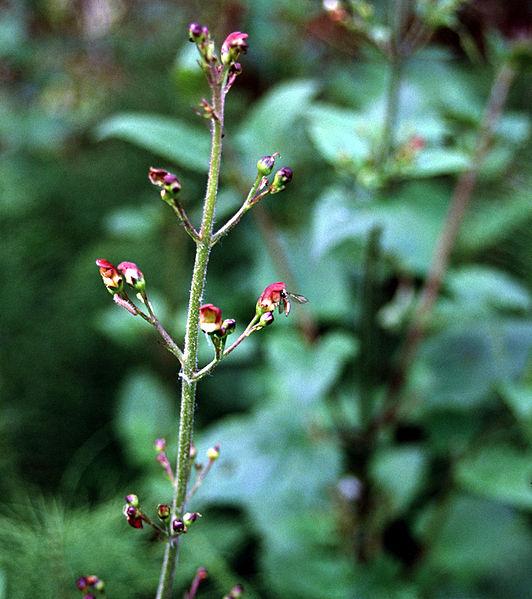
|
Sisyrinchium bellum
Pronunciation
si-si-RINK-ee-um BEL-lum
Common Name
Blue-Eyed Grass
Plant Type
Perennial
Mature Size
12 inches high x 6 inches - 2 feet wide
Water Requirements
Low: water every three weeks until the root ball is wet
Sun/Shade Requirements
Full to half sun
Wildlife
Flower Color
Blue
Where to See
Maintenance- Design- Planting Tips
This California native plant has green or bluish green strappy leaves. In early spring small blue flowers cover the plant. They are showiest when planted in masses. The clear-blue flowers are eye-catching in the spring garden. There are different cultivars that offer subtle variations.
PADG Notes: When Sisyrinchium bellum dies back with hot weather, the dried foliage is removed. With additional water throughout the summer, plants will stay evergreen and continue to occasionally rebloom. Some reseeding will occur, but not aggressively. |
Symphyotrichum chilense
Pronunciation
sim-fee-OT-ri-koom chi-LEN-see
Common Name
California Aster (Pacifc Aster)
Plant Type
Perennial
Mature Size
3 ft (0.9 m) wide x 1.3 - 3.3 ft. (0.4 - 1 m) tall
Water Requirements
Low: water every three weeks until the root ball is wet
Sun/Shade Requirements
Full to half sun
Wildlife
Flower Color
Blue, Lavender, Yellow
Where to See
Maintenance- Design- Planting Tips
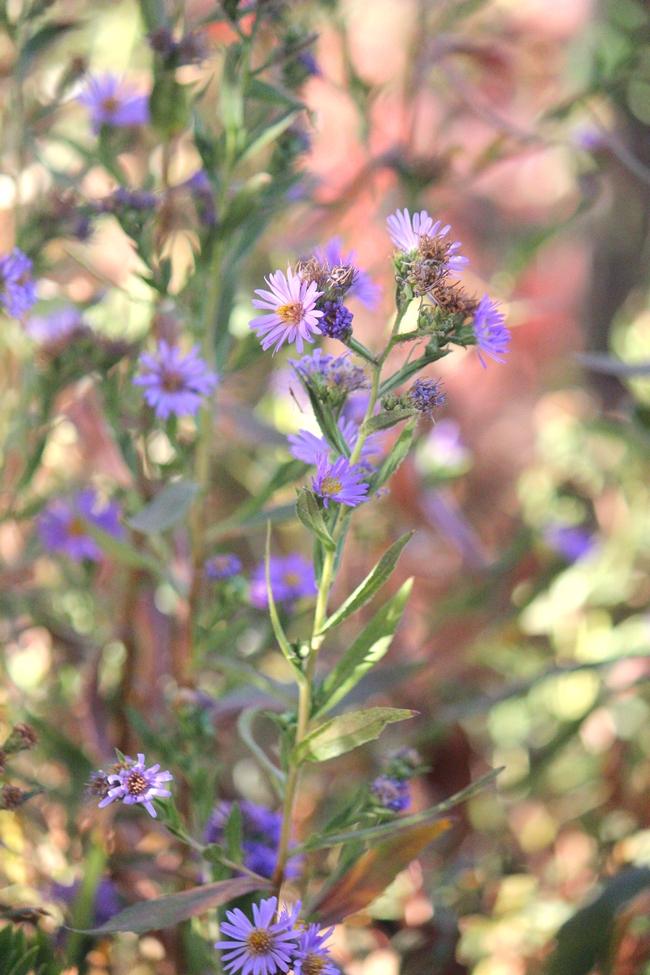
|
Tagetes lemmonii
Pronunciation
tah-JEE-deez lem-mon-ee-eye
Common Name
Mexican Bush Marigold
Plant Type
Perennial
Mature Size
4 ft. to 6 ft. wide and 3 ft. to 6 ft. tall
Water Requirements
Low: water every three weeks until the root ball is wet
Sun/Shade Requirements
Full to half sun
Wildlife
Flower Color
Where to See
Maintenance- Design- Planting Tips
Tagetes lemmonii is a sprawling shrub-like perennial with yellow flowers and aromatic leaves. The plant is originally from Mexico and the southwestern U.S.
PADG Notes: Mexican Bush Marigold can become large and ungainly, so we recommend shearing this plant several inches from the ground in the spring to keep the plant compact and give it a nice shape. Also, prune out any frost damage once the danger of frost is over. Tagetes lemmonii is not long-lived in the garden, but if you like yellow flowers and enjoy the smell of its leaves this plant is worth planting. In the demonstration garden we removed Tagetes lemmonii because it repeatedly suffered frost damage and was not attractive. |
Thalictrum fendleri var. polycarpum
Pronunciation
thuh-LIK-troom fend-LAH-ree
Common Name
Meadow Rue
Plant Type
Perennial
Mature Size
2 ft (0.6 m) wide x 2 - 4 ft (0.6 - 1.2 m) tall
Water Requirements
Moderate: water weekly until the root ball is wet
Sun/Shade Requirements
Half sun
Wildlife
Flower Color
Cream, Green, Yellow
Where to See
Maintenance- Design- Planting Tips
Meadow Rue is used in woodland and shade gardens as a perennial background plant. It has beautiful lacy blue-green foliage that unfurls from purplish shoots. The tiny unisexual flowers are produced atop 2 - 4 ft. tall stalks on separate plants. The male flowers are showier with dangling cream-yellow colored stamens; the female flowers are clusters of greenish pistils. It goes dormant in late summer when it is allowed to go dry. This Meadow Rue is easy to grow, in part sun to shade. It grows with occasional to regular irrigation, and can be drought-tolerant once established. |
Verbena bonariensis
Pronunciation
ver-BEE-na bo-nar-ee-EN-sis
Common Name
Verbena
Plant Type
Perennial
Mature Size
3-6 ft tall x 1-3 ft wide
Water Requirements
Low: water every three weeks until the root ball is wet
Sun/Shade Requirements
Full sun
Wildlife
Flower Color
Purple
Where to See
Maintenance- Design- Planting Tips
Best used as a background plant, Verbena bonariensis does best in hot, dry locations with good air circulation and well-draining soil.
This is a fast-growing plant, which if happy in the garden, will spread by seed. It has a small clump of green leaves that produce tall flowering stems in the hot summer months. The overall look is light and airy. Tall stems should be cut down when flowers have faded. PADG Notes: This plant is no longer in the garden because it needed some supplemental water to keep it thriving. |







